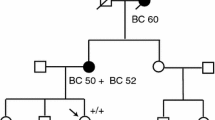Abstract
Nijmegen breakage syndrome is an autosomal recessive disorder caused by biallelic mutation in NBN gene. It is characterized by microcephaly, growth retardation, immuno-deficiency and cancer predisposition. The monoallelic carriers of NBN gene are also reported to be at increased risk of developing various types of malignancy. We have investigated an individual with lung cancer from an extended family segregating different types of hereditary cancer over several generations, including lung, breast, ovarian, colon, prostate and renal cancers. By using next generation whole exome sequencing approach, we identified a rare heterozygous frameshift mutation in NBN gene; c.93_94delTG (Ala32HisfsTer4), which is predicted to be pathogenic together with 3 other variants; 2 being in the BRCA1 gene, c.1648A > C (p.Asn550His) and c.536A > G (p.Tyr179Cys), and one in RAD50 gene, c.3539G > A (p.Arg1180Gln). Some of the variants were also found in six out of eight clinically normal relatives, but in different combinations. To our knowledge, this is the first report of NBN gene mutation in an individual with lung cancer in the Arab world. Reporting such findings may aid in variants’ risk classification and clinical decision in the future.


Similar content being viewed by others
References
Varon R, Vissinga C, Platzer M, Cerosaletti KM, Chrzanowska KH, Saar K et al (1998) Nibrin, a novel DNA double strand break repair protein, is mutated in Nijmegen breakage syndrome. Cell 93(3):467–476
Carney JP, Maser RS, Olivares H, Davis EM, Le Beau M, Yates JR 3rd et al (1998) The hMre11/hRad50 protein complex and Nijmegen breakage syndrome: linkage of double-strand break repair to the cellular DNA damage response. Cell 93(3):477–486
Futaki M, Lui JM (2001) Chromosome breakage syndromes and the BRCA1 genome surveillance complex. Trends Mol Med 7(12):560–565
Varon R, Seemanová E, Chrzanowska K, Hnateyko O, Piekutowska-Abramczuk D, Krajewska-Walasek M et al (2000) Clinical ascertainment of Nijmegen breakage syndrome (NBS) and prevalence of the major mutation, 657del5, in three Slav populations. Eur J Hum Genet 8(11):900–902
Seemanová E1, Jarolim P, Seeman P, Varon R, Digweed M, Swift M, Sperling K. (2007) Cancer risk of heterozygotes with the NBN founder mutation. JNCI J Natl Cancer Inst 99(24): 1875–1880
Fang W, Qiu F, Zhang L, Deng J, Zhang H, Yang L, Zhou Y, Lu J (2014) The functional polymorphism of NBS1 p.Glu185Gln is associated with an increased risk of lung cancer in Chinese populations: case-control and a meta-analysis. Mutat Res 770:61–68
Stenson PD, Mort M, Ball EV, Shaw K, Phillips A, Cooper DN (2014) The Human Gene Mutation Database: building a comprehensive mutation repository for clinical and molecular genetics, diagnostic testing and personalized genomic medicine. Hum Genet 133(1):1–9
Clarke L, Zheng-Bradley X, Smith R, Kulesha E, Xiao C, Toneva I, Vaughan B, Preuss D, Leinonen R, Shumway M, Sherry S, Flicek P (1000) Genomes Project Consortium (2012) The 1000 Genomes Project: data management and community access. Nat Methods 9(5):459–462
Fokkema IF, den Dunnen JT, Taschner PE (2005) LOVD: easy creation of a locus-specific sequence variation database using an “LSDB-in-a-box” approach. Hum Mutat 26(2):63–68
Forbes SA, Beare D, Gunasekaran P, Leung K, Bindal N, Boutselakis H et al (2015) COSMIC: exploring the world’s knowledge of somatic mutations in human cancer. Nucleic Acids Res 43 (Database issue):D805-811
Abdel-Rahman MH, Pilarski R, Cebulla CM et al (2011) Germline BAP1 mutation predisposes to uveal melanoma, lung adenocarcinoma, meningioma, and other cancers. J Med Genet 48(12):856–859
Helgadottir H, Höiom V, Jönsson G, Tuominen R, Ingvar C, Borg A, Olsson H, Hansson J (2014) High risk of tobacco-related cancers in CDKN2A mutation-positive melanoma families. J Med Genet 51(8):545–552
Wang Y, McKay JD, Rafnar T et al (2014) Rare variants of large effect in BRCA2 and CHEK2 affect risk of lung cancer. NatGenet 46(7):736–741
Renieri A, Mencarelli MA, Cetta F et al (2014) Oligogenic germline mutations identified in early non-smokers lung adenocarcinoma patients. Lung Cancer 85(2):168–174
Clamon GH, Bossler AD, Abu Hejleh T, Furqan M (2015) Germline mutations predisposing to non-small cell lung cancer. Fam Cancer 14(3):463–469
Tomoshige K, Matsumoto K, Tsuchiya T, Oikawa M, Miyazaki T, Yamasaki N, Mishima H, Kinoshita A, Kubo T, Fukushima K, Yoshiura KI, Nagayasu T (2015) Germline mutations causing familial lung cancer. J Hum Genet 60(10):597–603
El-Harith el-HA1, Abdel-Hadi MS, Steinmann D, Dork T (2002). BRCA1 and BRCA2 mutations in breast cancer patients from Saudi Arabia. Saudi Med J. 23(6):700–704
Spurdle AB, Lakhani SR, Healey S, Parry S, Da Silva LM, Brinkworth R, Hopper JL, Brown MA, Babikyan D, Chenevix-Trench G et al (2008) Clinical classification of BRCA1 and BRCA2 DNA sequence variants: the value of cytokeratin profiles and evolutionary analysis–a report from the kConFab Investigators. J Clin Oncol 26(10):1657–1663
Lindor NM1, Guidugli L, Wang X, Vallée MP, Monteiro AN, Tavtigian S, Goldgar DE, Couch FJ (2012) A review of a multifactorial probability-based model for classification of BRCA1 and BRCA2 variants of uncertain significance (VUS) Hum Mutat. 33(1):8–21
Park SL, Bastani D, Goldstein BY, Chang SC, Cozen W, Cai L et al (2010) Associations between NBS1 polymorphisms, haplotypes and smoking-related cancers. Carcinogenesis 31(7):1264–1271
Acknowledgements
We would like to thank the patient and her family for allowing publication of this case report. This work is based on the investigations provided to the patients as part of the free health services that are supported by the Ministry of Health, Kuwait.
Author information
Authors and Affiliations
Corresponding author
Ethics declarations
Conflict of interest
There is no conflict of interest to the publication of this article.
Rights and permissions
About this article
Cite this article
Marafie, M.J., Dashti, M. & Al-Mulla, F. Identification of a rare germline NBN gene mutation by whole exome sequencing in a lung-cancer survivor from a large family with various types of cancer. Familial Cancer 16, 389–394 (2017). https://doi.org/10.1007/s10689-016-9954-9
Published:
Issue Date:
DOI: https://doi.org/10.1007/s10689-016-9954-9




